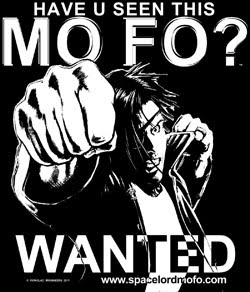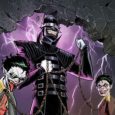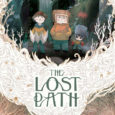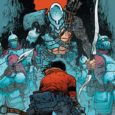In the words of creators Pat McNamara and David G. Williams, The Legend of SpaceLord Mo Fo is a digital comic that:
“follows the miss-adventures of Bran Mak Foo and Honey Pott, a young just-married couple scrounging a living in their dilapidated Ironclad-class deep-space freighter, the Qupid, on the Edge of Endspace; a vast region of space where no semblance of civilization has reemerged after a galactic apocalypse… or three. The Edge is a place where heroes are few, villains are plentiful, and the rest are just trying to survive.”

The Mo Fo himself, along with his sticky bride (who, as of episode 1, part 12, hasn’t been introduced yet. Still, her demeanor suggests that she is indeed a honey enthusiast).
This comic is still blood-and-placenta-covered young, so it’s tough to give a lengthy rundown on the details. But thus far, we’ve been introduced to Tomb Towers, a post-apocalyptic city on the coast of a dried up sea, where Bran Mak Foo has been playing cards and inspiring awe in the locals, with the likelihood of bloodletting about to occur any second, and with someone sinister approaching the city who probably doesn’t have a hug ready for the Mo Fo.
The world is richly detailed, with a convincing look of decayed technology and western motifs, filtered through an anime lens (I like the “Shells of the Bright Sea” saloon, with the neon burned out on every word except “hell,” and “sea”). The dialogue is sometimes weighed down with a tad too much local patois, such as “Ten took one of ’em mediearthal buster nukes up the ass and went f**kedbar during the third g’lactic ‘pocylypse!” But that’s a small portion of it so far, and it already has a couple of great lines, like “So we gonna dance mister, or does one eye mean it takes twice as long to read them cards?”
The biggest draw–and the biggest challenge–is the digital nature of this comic. I’ve been reading digital editions of standard graphic novels on my kindle fire for a while, but The Legend of SpaceLord Mo Fo was actually the first comic I’ve been introduced to that was designed specifically for teh internets. In his Why Digital? press release, writer Pat McNamara has this to say about digital comics:
“As far as storytelling goes, what the digital medium does most effectively is give the creator greater
control over how their story is revealed to the reader. Traditional comics present a sequence of panels
over one or two pages, where the reader is led from panel to panel by the way the panels are presented
on the page, and yet, all is revealed in some manner to the reader as soon as they look at them. While
creators can time their big reveal moments to the turning of the page, a Digital Comic allows for
control of the how and where of every reveal, be it action or dialogue or sound effect. In the same way
a reader turns the page of a traditional comic to reveal what happens next, a touch of the screen, or a
mouse click if viewing on the PC, advances the digital comic to the next moment in the story.”
Now, I give big hairy kudos to McNamara and Williams for doing this, because I can’t even begin to imagine the hostility that must come from some corners of the fanboy purist camp:

Oh dear, my simple little friend, are we still fussing about with that digital comic poppycock? It’s rather like that synthesized music nonsense–all that electronic bleeping, and the blooping, and whatnot. Be a proper fellow and return to print, post haste, or I shall be forced to craft a searing indictment of your “work” and link it to all pertinent parties on these so called “world wide webs.”
McNamara’s right to refer to digital comics as a frontier. And like all frontiers, there’s no map or signposts, and some comics are going to thrive in the unlimited freedom of the digital wilds, and some are going to get scalped by the locals, or get hopelessly lost and stranded when their creative winter comes and be forced to cannibalize parts of themselves to survive.
As for The Legend of SpaceLord Mo Fo, I think it does a lot of things right with this newly-minted freedom. And some of it, well, might just not be for me. I found the options for presenting and revealing dialogue to be greatly enhanced by Mo Fo’s digital nature, while some of the scenes indicating motion to be a little unbalanced.
At the comic’s start, a series of scenes are presented in a way that simulates a tracking shot in a film, where a character runs toward the city of Tomb Towers. The first time I clicked through it, it seemed to drag a little long, and felt more like a few frames of a stop-motion feature than a comic.
Another scene occurs where a character does the timeless western classic of sweeping his coat back to reveal his gun holster. In a traditional comic, this might have been done by showing the characters squaring off, then a new panel that zooms in for a close-up on the holster, then a new panel that establishes a wider frame of reference, yada yada. In Mo Fo, the panel stays more or less the same, while each click of the mouse triggers the character to move his arm back to reveal the gun, then forward again, etc. The frame of reference stays the same, with minor motions from the character.
I appreciate what they’re trying to do with this, and it’s certainly done smoothly enough. But for me personally, it takes me out of the story a bit. What I’ve always loved in graphic novels is the extreme details they can offer: how you can linger on any panel for as long as you like, and notice how well-built the world is, and experience that unique fusion of dialogue, internal character perspective, and beautiful images. But I’ve never seen comics as needing to simulate motion. I like the idea of each panel being a work of art unto itself, something you could blow up and frame. Having the appearance of movement in the comic can transform it from being a series of world-class static images to a poorly made animation.
Nothing in SpaceLord Mo Fo is that blunt or sloppy. And again, I may be the only one who feels this way. But there was a time or two where I thought a new perspective was needed for a panel, and less things like the eyes of a character moving, mouths opening and closing, etc.
Where the comic excels is the dialogue structure. In a traditional comic, a panel can quickly become cluttered and confusing if there are more than four or five dialogue bubbles, especially when they occur as a give-and-take between two characters. The digital nature of Mo Fo allows for dialogue to pop up one bubble at a time, in the order they’re meant to be read. This allows for a much tighter control on the flow and pacing of the story, without re-arranging panels and pages to separate dialogue, or hide an important reveal. Mo Fo triggered the happiness parts in my brain many times with this technique.
All in all, I’ll definitely be checking back for episode updates for The Legend of SpaceLord Mo Fo. So should you.
















